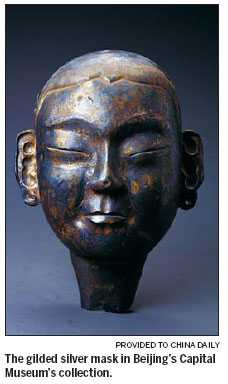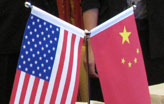high-speed rail special
Liao masks offer rare peek into life of Qidan people
Updated: 2011-07-19 07:55
By Zhang zixuan (China Daily)

Editor's Note: Every week we look at a work of art or a cultural relic that puts the spotlight on China's heritage.
The Qidan, also called Khitan, were an ethnic group who inhabited the broad grasslands of North China more than 1,000 years ago.
They built the empire of the Liao Dynasty ((907-1125) in East Asia that ruled over the regions of Manchuria, Mongolia, and parts of northern China.
Their rule overlapped with that of the Five Dynasties and Ten Kingdoms (AD 907-960) and the Northern Song Dynasty (960-1127) in other parts of China.
They were finally overthrown by another ethnic group that founded the Jin Dynasty (1115-1234).
Little is known about the Qidan lifestyle but the few artifacts now housed in Beijing's Capital Museum provide some clues.
Take the gilded silver mask.
The well-preserved mask, unearthed from Longkou village in Beijing, is made of a sheet of silver and shows a face with combed-back hair, the eyes and lips closed. The gold on it is nearly all gone.
The funerary mask belonged to a female Qidan noble.
"The Qidan believed that if one's body could be preserved, the spirit would stay forever," Tang Guoyao, associate researcher of the Capital Museum, says.
Like the ancient Egyptians, the Qidan mummified their dead, covering the face with a metal mask and the body with a net made of silver threads.
More than 100 such Liao masks have been excavated, mostly from the Inner Mongolia autonomous region.
Some are of pure gold and some are gilded. There are also those made of silver and copper, reflecting a highly hierarchical nobility.

Two gold masks, now kept in the Inner Mongolia Museum, belonged to a princess and her husband of a kingdom called Chen of the Liao Dynasty, and tell of their supreme status.
Many theories, of which three have gained currency, have been put forward as to the origin of this Qidan custom.
One says the Qidan embraced shamanism, which believes everything has a spirit. The Liao masks look very similar to what the shamans wore at their religious rituals.
Another holds the custom comes from Buddhism, which was also popular among the Qidan. And gold-faced Buddhas and Bodhisattvas were considered particularly sacred. Women even daubed their faces with yellow paint to mimic the Buddha.
The third and perhaps the most convincing says that during the Han Dynasty (206 BC-AD 220), when members of the royal family died, their bodies would be covered with what was called Jade Clothes Sewn with Golden Thread.
It is very likely the Qidan borrowed this as their funerary masks and net shrouds are quite similar to the Jade Clothes Sewn with Golden Thread.
China Daily
(China Daily 07/19/2011 page18)

Specials

China-US Governors Forum
The first China-US Governors Forum is held July 15 in the Salt Lake City, the United States.

My China story
Foreign readers are invited to share your China stories.

Rare earths export quota
China kept its export quota at almost the same level as last year.